Pathophysiology and Pharmacology Relating to a Case
VerifiedAdded on 2023/01/19
|11
|3092
|31
AI Summary
This document discusses the pathophysiology and pharmacology of a case involving a boy with asthma. It explores the symptoms, medications, and their connection to the disease.
Contribute Materials
Your contribution can guide someone’s learning journey. Share your
documents today.
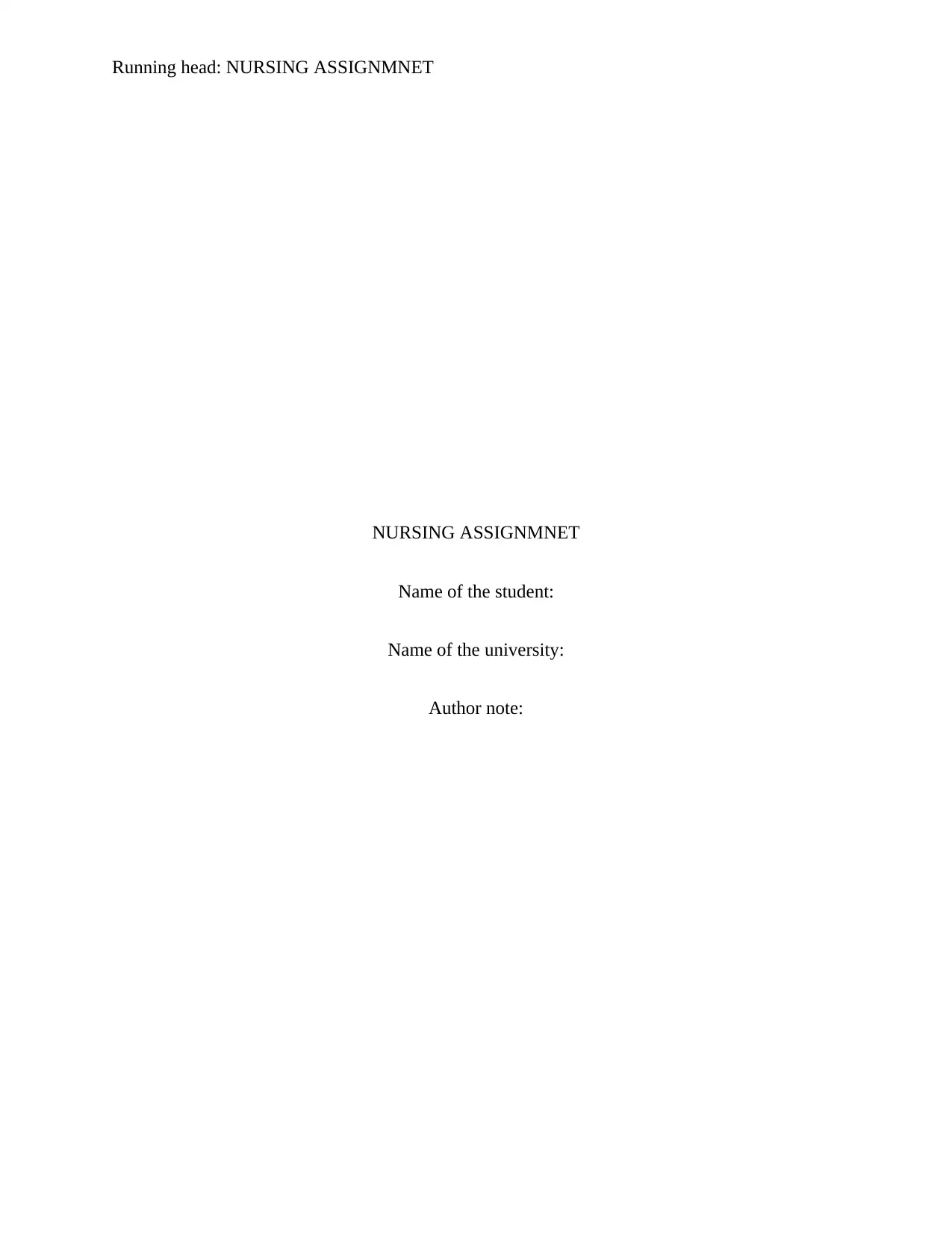
Running head: NURSING ASSIGNMNET
NURSING ASSIGNMNET
Name of the student:
Name of the university:
Author note:
NURSING ASSIGNMNET
Name of the student:
Name of the university:
Author note:
Secure Best Marks with AI Grader
Need help grading? Try our AI Grader for instant feedback on your assignments.
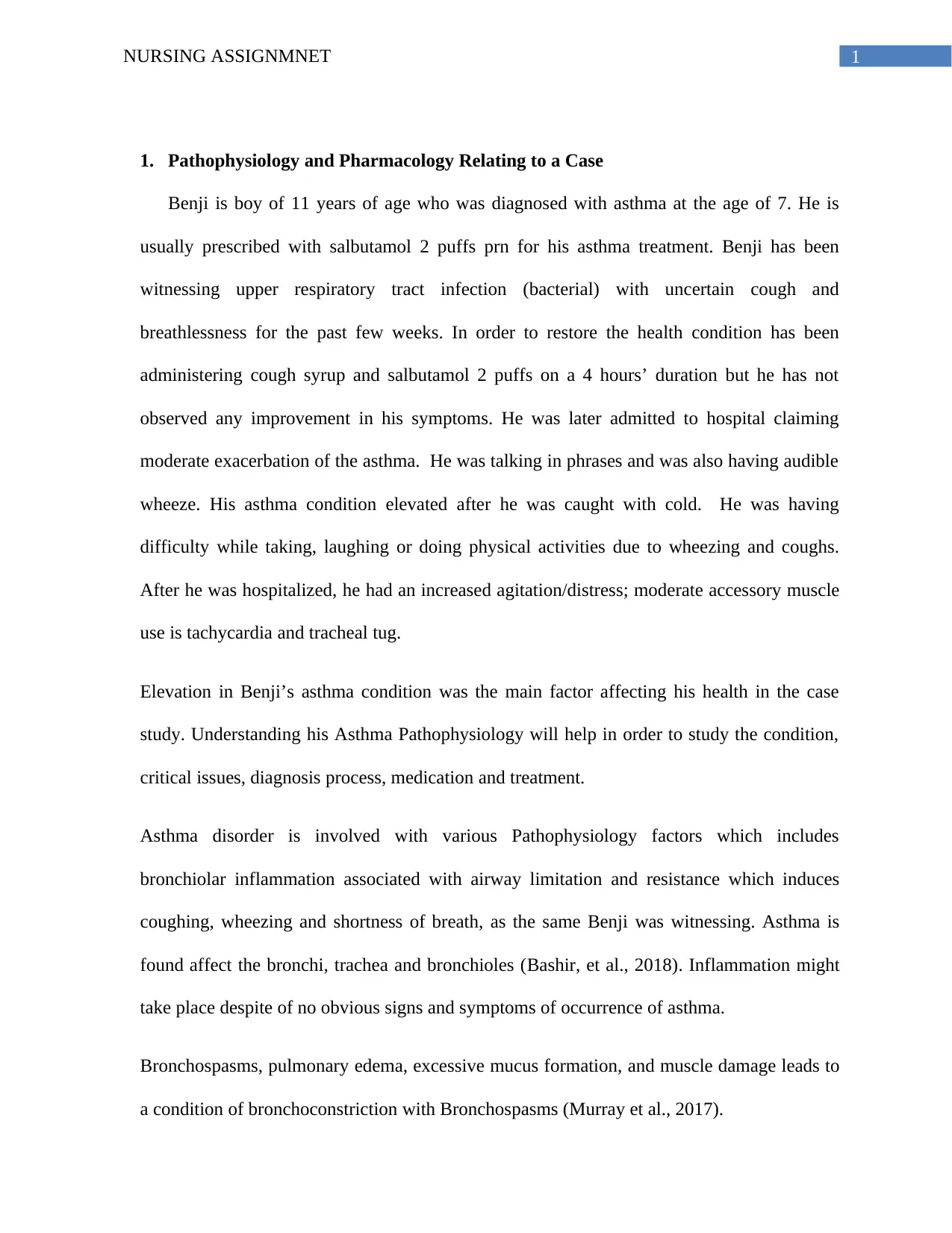
1NURSING ASSIGNMNET
1. Pathophysiology and Pharmacology Relating to a Case
Benji is boy of 11 years of age who was diagnosed with asthma at the age of 7. He is
usually prescribed with salbutamol 2 puffs prn for his asthma treatment. Benji has been
witnessing upper respiratory tract infection (bacterial) with uncertain cough and
breathlessness for the past few weeks. In order to restore the health condition has been
administering cough syrup and salbutamol 2 puffs on a 4 hours’ duration but he has not
observed any improvement in his symptoms. He was later admitted to hospital claiming
moderate exacerbation of the asthma. He was talking in phrases and was also having audible
wheeze. His asthma condition elevated after he was caught with cold. He was having
difficulty while taking, laughing or doing physical activities due to wheezing and coughs.
After he was hospitalized, he had an increased agitation/distress; moderate accessory muscle
use is tachycardia and tracheal tug.
Elevation in Benji’s asthma condition was the main factor affecting his health in the case
study. Understanding his Asthma Pathophysiology will help in order to study the condition,
critical issues, diagnosis process, medication and treatment.
Asthma disorder is involved with various Pathophysiology factors which includes
bronchiolar inflammation associated with airway limitation and resistance which induces
coughing, wheezing and shortness of breath, as the same Benji was witnessing. Asthma is
found affect the bronchi, trachea and bronchioles (Bashir, et al., 2018). Inflammation might
take place despite of no obvious signs and symptoms of occurrence of asthma.
Bronchospasms, pulmonary edema, excessive mucus formation, and muscle damage leads to
a condition of bronchoconstriction with Bronchospasms (Murray et al., 2017).
1. Pathophysiology and Pharmacology Relating to a Case
Benji is boy of 11 years of age who was diagnosed with asthma at the age of 7. He is
usually prescribed with salbutamol 2 puffs prn for his asthma treatment. Benji has been
witnessing upper respiratory tract infection (bacterial) with uncertain cough and
breathlessness for the past few weeks. In order to restore the health condition has been
administering cough syrup and salbutamol 2 puffs on a 4 hours’ duration but he has not
observed any improvement in his symptoms. He was later admitted to hospital claiming
moderate exacerbation of the asthma. He was talking in phrases and was also having audible
wheeze. His asthma condition elevated after he was caught with cold. He was having
difficulty while taking, laughing or doing physical activities due to wheezing and coughs.
After he was hospitalized, he had an increased agitation/distress; moderate accessory muscle
use is tachycardia and tracheal tug.
Elevation in Benji’s asthma condition was the main factor affecting his health in the case
study. Understanding his Asthma Pathophysiology will help in order to study the condition,
critical issues, diagnosis process, medication and treatment.
Asthma disorder is involved with various Pathophysiology factors which includes
bronchiolar inflammation associated with airway limitation and resistance which induces
coughing, wheezing and shortness of breath, as the same Benji was witnessing. Asthma is
found affect the bronchi, trachea and bronchioles (Bashir, et al., 2018). Inflammation might
take place despite of no obvious signs and symptoms of occurrence of asthma.
Bronchospasms, pulmonary edema, excessive mucus formation, and muscle damage leads to
a condition of bronchoconstriction with Bronchospasms (Murray et al., 2017).

2NURSING ASSIGNMNET
Benji was administered with various medications following his present health condition and
his health reports. He was taking Salbutamol 100 μg 12 puffs with the help of metered dose
inhaler (MDI) for 20 minutes for 3 times which is used to clear open the medium and large
lung airways to increasing breathing and restore airway blockage, Oral Prednisolone 1mg/kg
(maximum 60mg) for not more than one to two days which is administered for conditions
like inflammation, SpO2 under 93% administer with 2L of oxygen for the shortness of
breath as he was not able to breathe appropriately, Ipratropium 8 puffs (20μg/puff) – which is
directed to be administered immediately after taking Salbutamol dose using spacer (20
minutes for 3 times) and it is used to treat patient with chronic pulmonary and asthma
conditions (McGeachie et al., 2016).
2. The pharmacokinetics and pharmaco-dynamics of the pharmacology for the patient
The pharmacokinetics and pharmacodynamics of the pharmacology of the patient in the
case is a major part of the treatment and care process. When Benji was admitted to the
hospital, he was provided with oxygen therapy which is an essential requirement for an
asthma patient (Abadoglu & Berk, 2016). As he was witnessing shortness of breath, it was
necessary to provide him with supplement oxygen, as asthma creates a condition where the
lungs and the respiratory tract get blocked and inflammated. Because of the condition of the
respiratory tract the patient suffers from breathing issue. Benji was also administered with
Salbutamol which is used in patients suffering from asthma. The drug is metabolized in the
liver and can easily excrete through urination. Salbutamol has an advanced capability of
passage the blood-brain barrier. The drugs are most frequently and most preferred drugs for
asthma patients as it has an effective health resolving feature (Katsunuma et al., 2019).
Benji was administered with various medications following his present health condition and
his health reports. He was taking Salbutamol 100 μg 12 puffs with the help of metered dose
inhaler (MDI) for 20 minutes for 3 times which is used to clear open the medium and large
lung airways to increasing breathing and restore airway blockage, Oral Prednisolone 1mg/kg
(maximum 60mg) for not more than one to two days which is administered for conditions
like inflammation, SpO2 under 93% administer with 2L of oxygen for the shortness of
breath as he was not able to breathe appropriately, Ipratropium 8 puffs (20μg/puff) – which is
directed to be administered immediately after taking Salbutamol dose using spacer (20
minutes for 3 times) and it is used to treat patient with chronic pulmonary and asthma
conditions (McGeachie et al., 2016).
2. The pharmacokinetics and pharmaco-dynamics of the pharmacology for the patient
The pharmacokinetics and pharmacodynamics of the pharmacology of the patient in the
case is a major part of the treatment and care process. When Benji was admitted to the
hospital, he was provided with oxygen therapy which is an essential requirement for an
asthma patient (Abadoglu & Berk, 2016). As he was witnessing shortness of breath, it was
necessary to provide him with supplement oxygen, as asthma creates a condition where the
lungs and the respiratory tract get blocked and inflammated. Because of the condition of the
respiratory tract the patient suffers from breathing issue. Benji was also administered with
Salbutamol which is used in patients suffering from asthma. The drug is metabolized in the
liver and can easily excrete through urination. Salbutamol has an advanced capability of
passage the blood-brain barrier. The drugs are most frequently and most preferred drugs for
asthma patients as it has an effective health resolving feature (Katsunuma et al., 2019).
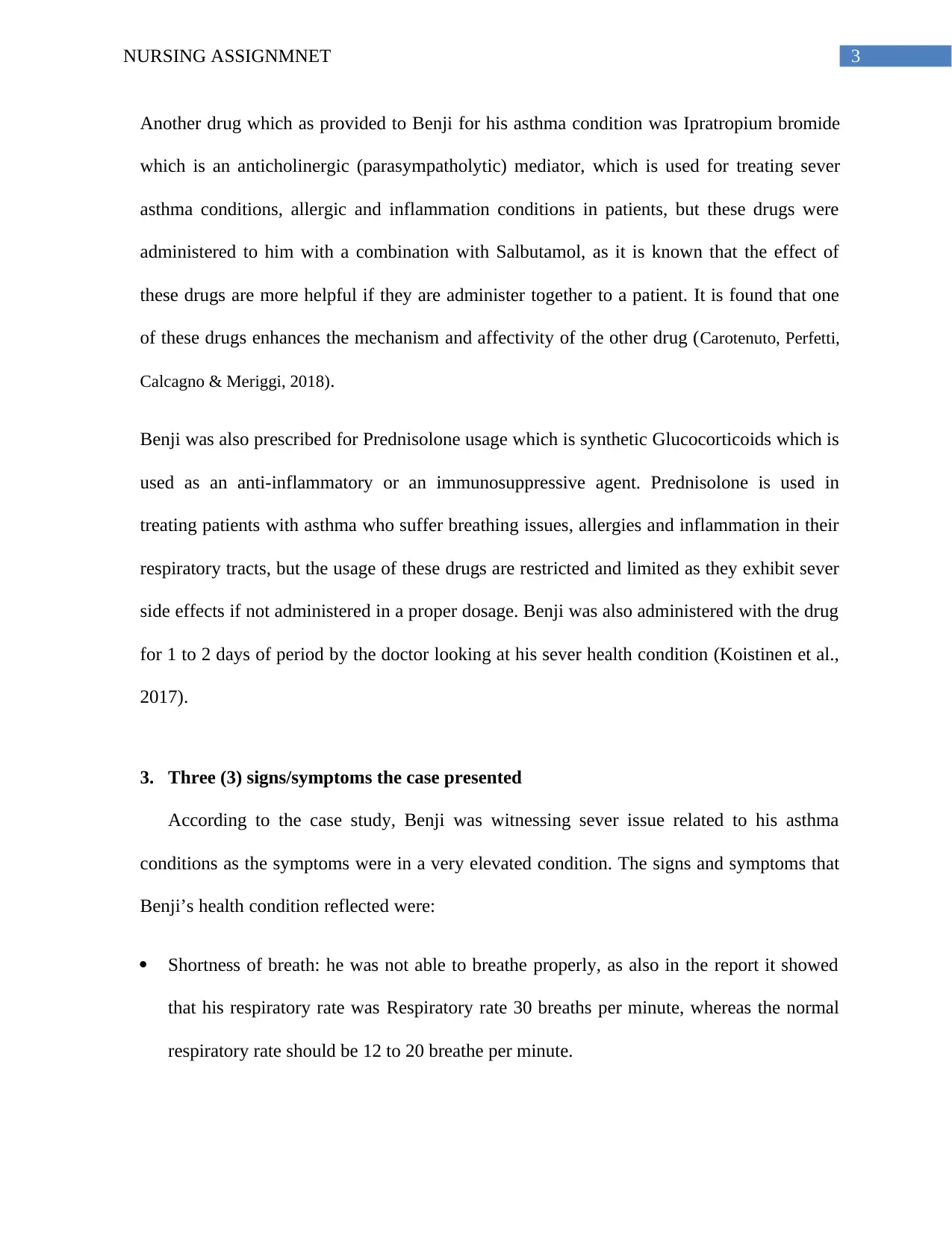
3NURSING ASSIGNMNET
Another drug which as provided to Benji for his asthma condition was Ipratropium bromide
which is an anticholinergic (parasympatholytic) mediator, which is used for treating sever
asthma conditions, allergic and inflammation conditions in patients, but these drugs were
administered to him with a combination with Salbutamol, as it is known that the effect of
these drugs are more helpful if they are administer together to a patient. It is found that one
of these drugs enhances the mechanism and affectivity of the other drug (Carotenuto, Perfetti,
Calcagno & Meriggi, 2018).
Benji was also prescribed for Prednisolone usage which is synthetic Glucocorticoids which is
used as an anti-inflammatory or an immunosuppressive agent. Prednisolone is used in
treating patients with asthma who suffer breathing issues, allergies and inflammation in their
respiratory tracts, but the usage of these drugs are restricted and limited as they exhibit sever
side effects if not administered in a proper dosage. Benji was also administered with the drug
for 1 to 2 days of period by the doctor looking at his sever health condition (Koistinen et al.,
2017).
3. Three (3) signs/symptoms the case presented
According to the case study, Benji was witnessing sever issue related to his asthma
conditions as the symptoms were in a very elevated condition. The signs and symptoms that
Benji’s health condition reflected were:
Shortness of breath: he was not able to breathe properly, as also in the report it showed
that his respiratory rate was Respiratory rate 30 breaths per minute, whereas the normal
respiratory rate should be 12 to 20 breathe per minute.
Another drug which as provided to Benji for his asthma condition was Ipratropium bromide
which is an anticholinergic (parasympatholytic) mediator, which is used for treating sever
asthma conditions, allergic and inflammation conditions in patients, but these drugs were
administered to him with a combination with Salbutamol, as it is known that the effect of
these drugs are more helpful if they are administer together to a patient. It is found that one
of these drugs enhances the mechanism and affectivity of the other drug (Carotenuto, Perfetti,
Calcagno & Meriggi, 2018).
Benji was also prescribed for Prednisolone usage which is synthetic Glucocorticoids which is
used as an anti-inflammatory or an immunosuppressive agent. Prednisolone is used in
treating patients with asthma who suffer breathing issues, allergies and inflammation in their
respiratory tracts, but the usage of these drugs are restricted and limited as they exhibit sever
side effects if not administered in a proper dosage. Benji was also administered with the drug
for 1 to 2 days of period by the doctor looking at his sever health condition (Koistinen et al.,
2017).
3. Three (3) signs/symptoms the case presented
According to the case study, Benji was witnessing sever issue related to his asthma
conditions as the symptoms were in a very elevated condition. The signs and symptoms that
Benji’s health condition reflected were:
Shortness of breath: he was not able to breathe properly, as also in the report it showed
that his respiratory rate was Respiratory rate 30 breaths per minute, whereas the normal
respiratory rate should be 12 to 20 breathe per minute.
Paraphrase This Document
Need a fresh take? Get an instant paraphrase of this document with our AI Paraphraser

4NURSING ASSIGNMNET
Wheezing and cough: he was witnessing cough and wheezing whenever he was trying to
talk, laugh or play. He was not able to sleep, as the wheezing and cough was elevation as
he was trying to lie down.
Distress, pain in the chest and difficulty and tiredness in performing physical activity : he
was not able to do anything, such as walking, running or playing, his chest pain was
increasing and he was getting tired very soon whenever he was trying to perform any
activity.
4. 3 medications related to the Pathophysiology of the patient
1. Salbutamol 100 μg, about 12 puffs using the metered dose inhaler (MDI) for 20 minutes
for 3 times
2. Oral Prednisolone 1mg/kg which was maximum provided 60mg and was provided for
initially continuation of 1 – 2 days
3. Ipratropium, approx 8 puffs (20μg/puff) and it was given immediately after each dose of
Salbutamol using spacer ( for 20 minutes for 3 times).
5. 3 appropriate signs/symptoms as related to the patient and their connection to the
Pathophysiology of disease
Shortness of breath: Shortness of breath rate is the major primary symptom of asthma,
which is a imparity of lung’s airways witnessed when there are inflammation and
blockage. Asthma patients are more susceptible to shortness of breath as the infection
effects the lungs of the patient. The patients with asthma very frequently face issues like
shortness of breath in their health condition and are prone to various allergies related to
respiratory tract (Abuel-Reesh, 2017).
Wheezing and cough: he was witnessing cough and wheezing whenever he was trying to
talk, laugh or play. He was not able to sleep, as the wheezing and cough was elevation as
he was trying to lie down.
Distress, pain in the chest and difficulty and tiredness in performing physical activity : he
was not able to do anything, such as walking, running or playing, his chest pain was
increasing and he was getting tired very soon whenever he was trying to perform any
activity.
4. 3 medications related to the Pathophysiology of the patient
1. Salbutamol 100 μg, about 12 puffs using the metered dose inhaler (MDI) for 20 minutes
for 3 times
2. Oral Prednisolone 1mg/kg which was maximum provided 60mg and was provided for
initially continuation of 1 – 2 days
3. Ipratropium, approx 8 puffs (20μg/puff) and it was given immediately after each dose of
Salbutamol using spacer ( for 20 minutes for 3 times).
5. 3 appropriate signs/symptoms as related to the patient and their connection to the
Pathophysiology of disease
Shortness of breath: Shortness of breath rate is the major primary symptom of asthma,
which is a imparity of lung’s airways witnessed when there are inflammation and
blockage. Asthma patients are more susceptible to shortness of breath as the infection
effects the lungs of the patient. The patients with asthma very frequently face issues like
shortness of breath in their health condition and are prone to various allergies related to
respiratory tract (Abuel-Reesh, 2017).
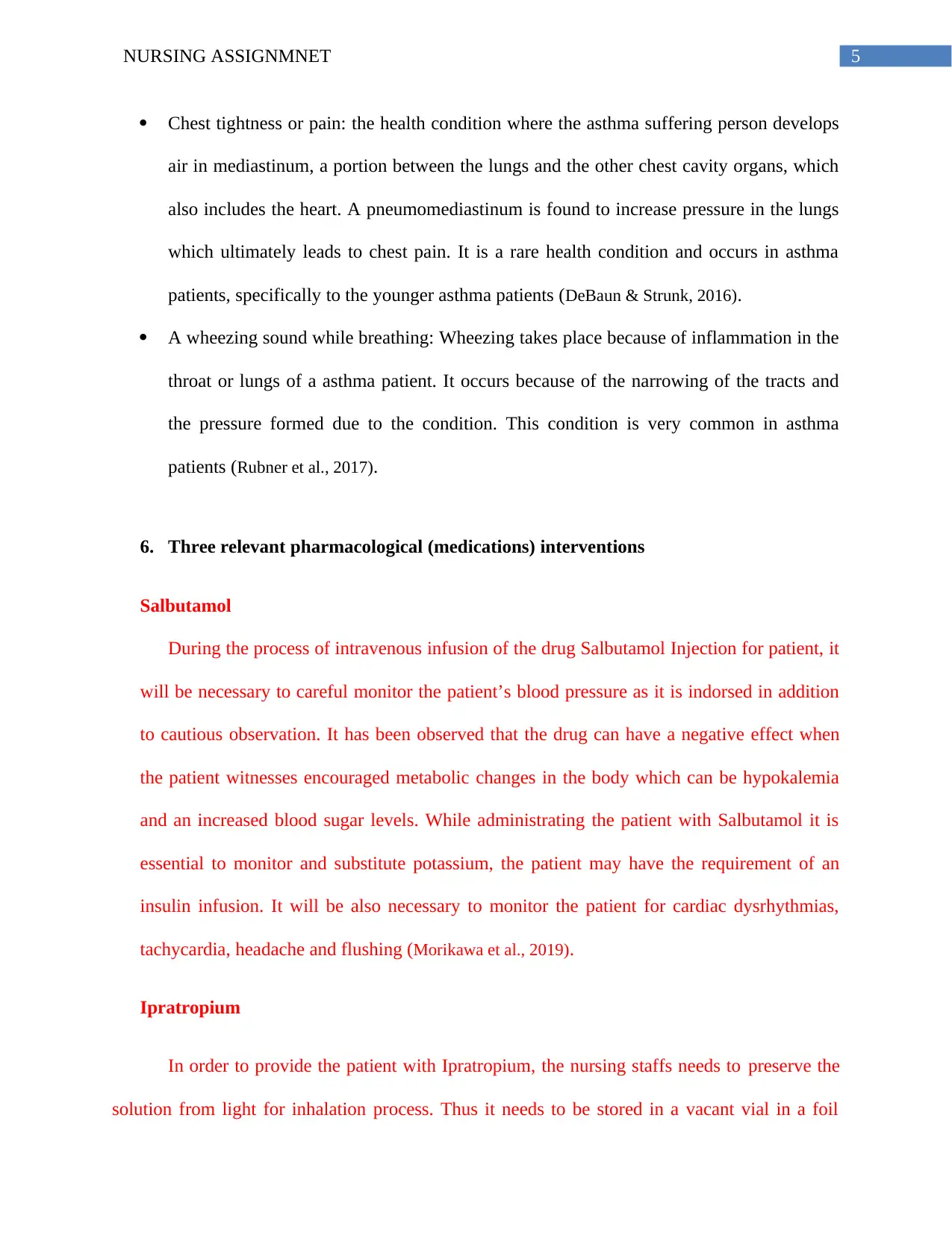
5NURSING ASSIGNMNET
Chest tightness or pain: the health condition where the asthma suffering person develops
air in mediastinum, a portion between the lungs and the other chest cavity organs, which
also includes the heart. A pneumomediastinum is found to increase pressure in the lungs
which ultimately leads to chest pain. It is a rare health condition and occurs in asthma
patients, specifically to the younger asthma patients (DeBaun & Strunk, 2016).
A wheezing sound while breathing: Wheezing takes place because of inflammation in the
throat or lungs of a asthma patient. It occurs because of the narrowing of the tracts and
the pressure formed due to the condition. This condition is very common in asthma
patients (Rubner et al., 2017).
6. Three relevant pharmacological (medications) interventions
Salbutamol
During the process of intravenous infusion of the drug Salbutamol Injection for patient, it
will be necessary to careful monitor the patient’s blood pressure as it is indorsed in addition
to cautious observation. It has been observed that the drug can have a negative effect when
the patient witnesses encouraged metabolic changes in the body which can be hypokalemia
and an increased blood sugar levels. While administrating the patient with Salbutamol it is
essential to monitor and substitute potassium, the patient may have the requirement of an
insulin infusion. It will be also necessary to monitor the patient for cardiac dysrhythmias,
tachycardia, headache and flushing (Morikawa et al., 2019).
Ipratropium
In order to provide the patient with Ipratropium, the nursing staffs needs to preserve the
solution from light for inhalation process. Thus it needs to be stored in a vacant vial in a foil
Chest tightness or pain: the health condition where the asthma suffering person develops
air in mediastinum, a portion between the lungs and the other chest cavity organs, which
also includes the heart. A pneumomediastinum is found to increase pressure in the lungs
which ultimately leads to chest pain. It is a rare health condition and occurs in asthma
patients, specifically to the younger asthma patients (DeBaun & Strunk, 2016).
A wheezing sound while breathing: Wheezing takes place because of inflammation in the
throat or lungs of a asthma patient. It occurs because of the narrowing of the tracts and
the pressure formed due to the condition. This condition is very common in asthma
patients (Rubner et al., 2017).
6. Three relevant pharmacological (medications) interventions
Salbutamol
During the process of intravenous infusion of the drug Salbutamol Injection for patient, it
will be necessary to careful monitor the patient’s blood pressure as it is indorsed in addition
to cautious observation. It has been observed that the drug can have a negative effect when
the patient witnesses encouraged metabolic changes in the body which can be hypokalemia
and an increased blood sugar levels. While administrating the patient with Salbutamol it is
essential to monitor and substitute potassium, the patient may have the requirement of an
insulin infusion. It will be also necessary to monitor the patient for cardiac dysrhythmias,
tachycardia, headache and flushing (Morikawa et al., 2019).
Ipratropium
In order to provide the patient with Ipratropium, the nursing staffs needs to preserve the
solution from light for inhalation process. Thus it needs to be stored in a vacant vial in a foil
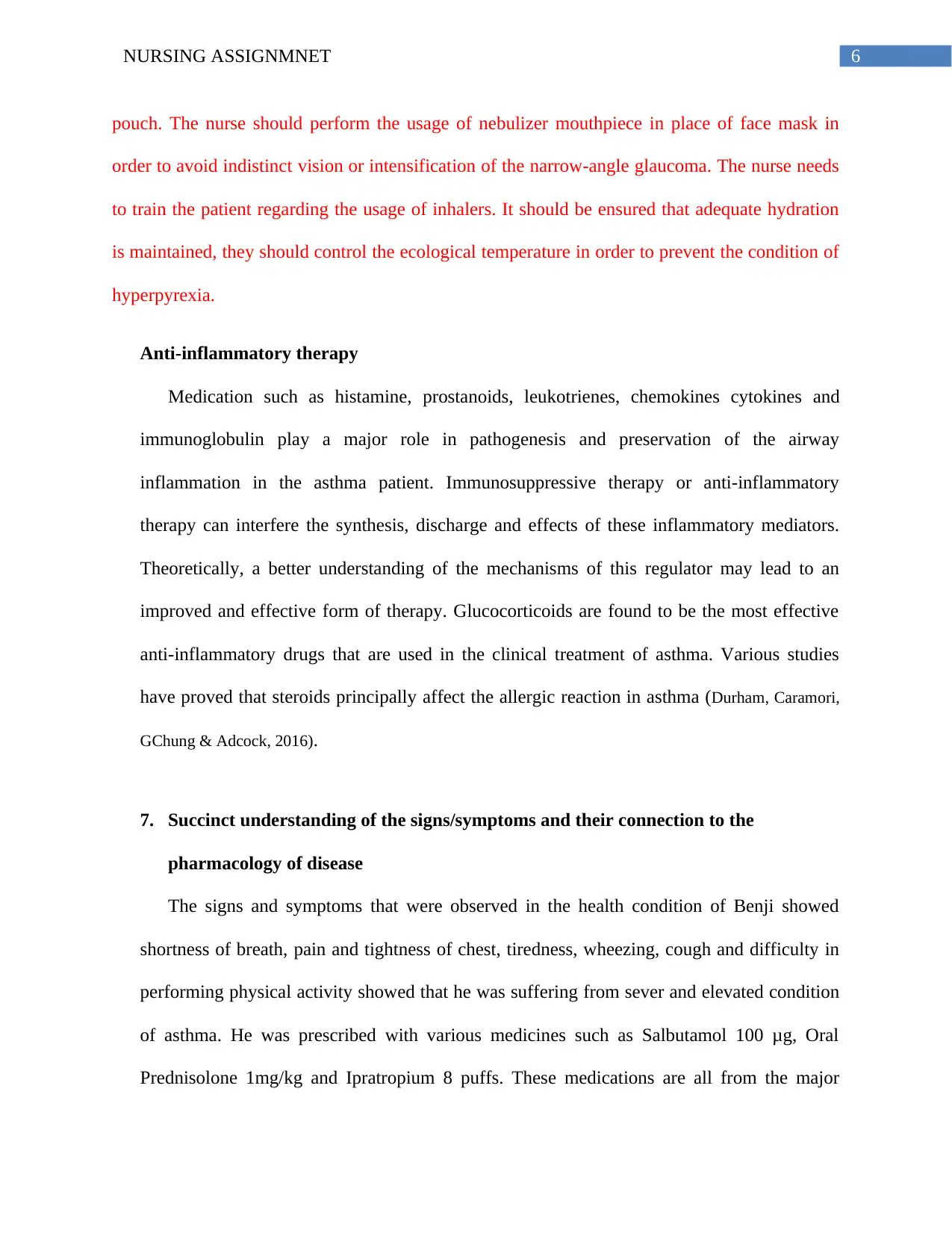
6NURSING ASSIGNMNET
pouch. The nurse should perform the usage of nebulizer mouthpiece in place of face mask in
order to avoid indistinct vision or intensification of the narrow-angle glaucoma. The nurse needs
to train the patient regarding the usage of inhalers. It should be ensured that adequate hydration
is maintained, they should control the ecological temperature in order to prevent the condition of
hyperpyrexia.
Anti-inflammatory therapy
Medication such as histamine, prostanoids, leukotrienes, chemokines cytokines and
immunoglobulin play a major role in pathogenesis and preservation of the airway
inflammation in the asthma patient. Immunosuppressive therapy or anti-inflammatory
therapy can interfere the synthesis, discharge and effects of these inflammatory mediators.
Theoretically, a better understanding of the mechanisms of this regulator may lead to an
improved and effective form of therapy. Glucocorticoids are found to be the most effective
anti-inflammatory drugs that are used in the clinical treatment of asthma. Various studies
have proved that steroids principally affect the allergic reaction in asthma (Durham, Caramori,
GChung & Adcock, 2016).
7. Succinct understanding of the signs/symptoms and their connection to the
pharmacology of disease
The signs and symptoms that were observed in the health condition of Benji showed
shortness of breath, pain and tightness of chest, tiredness, wheezing, cough and difficulty in
performing physical activity showed that he was suffering from sever and elevated condition
of asthma. He was prescribed with various medicines such as Salbutamol 100 μg, Oral
Prednisolone 1mg/kg and Ipratropium 8 puffs. These medications are all from the major
pouch. The nurse should perform the usage of nebulizer mouthpiece in place of face mask in
order to avoid indistinct vision or intensification of the narrow-angle glaucoma. The nurse needs
to train the patient regarding the usage of inhalers. It should be ensured that adequate hydration
is maintained, they should control the ecological temperature in order to prevent the condition of
hyperpyrexia.
Anti-inflammatory therapy
Medication such as histamine, prostanoids, leukotrienes, chemokines cytokines and
immunoglobulin play a major role in pathogenesis and preservation of the airway
inflammation in the asthma patient. Immunosuppressive therapy or anti-inflammatory
therapy can interfere the synthesis, discharge and effects of these inflammatory mediators.
Theoretically, a better understanding of the mechanisms of this regulator may lead to an
improved and effective form of therapy. Glucocorticoids are found to be the most effective
anti-inflammatory drugs that are used in the clinical treatment of asthma. Various studies
have proved that steroids principally affect the allergic reaction in asthma (Durham, Caramori,
GChung & Adcock, 2016).
7. Succinct understanding of the signs/symptoms and their connection to the
pharmacology of disease
The signs and symptoms that were observed in the health condition of Benji showed
shortness of breath, pain and tightness of chest, tiredness, wheezing, cough and difficulty in
performing physical activity showed that he was suffering from sever and elevated condition
of asthma. He was prescribed with various medicines such as Salbutamol 100 μg, Oral
Prednisolone 1mg/kg and Ipratropium 8 puffs. These medications are all from the major
Secure Best Marks with AI Grader
Need help grading? Try our AI Grader for instant feedback on your assignments.
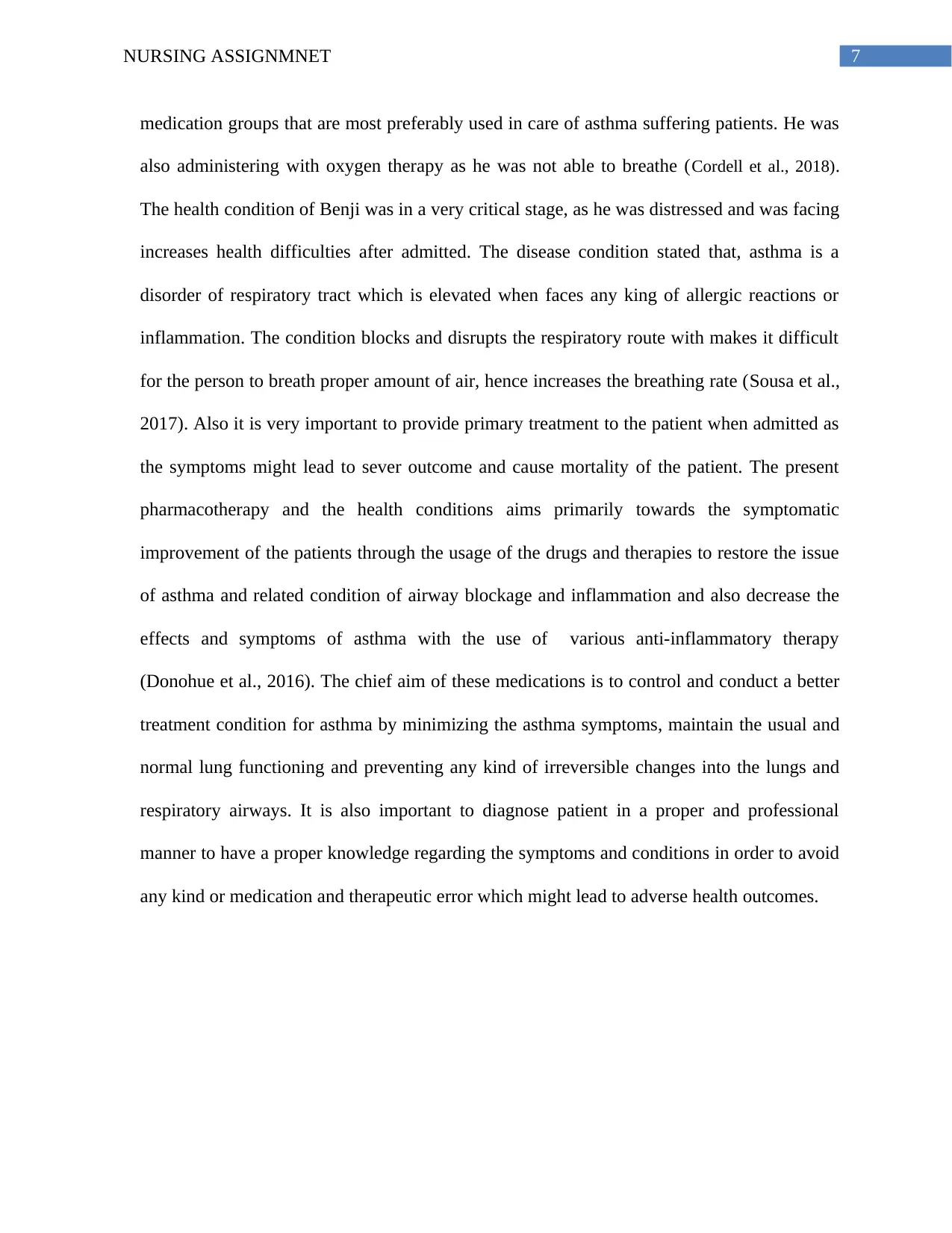
7NURSING ASSIGNMNET
medication groups that are most preferably used in care of asthma suffering patients. He was
also administering with oxygen therapy as he was not able to breathe (Cordell et al., 2018).
The health condition of Benji was in a very critical stage, as he was distressed and was facing
increases health difficulties after admitted. The disease condition stated that, asthma is a
disorder of respiratory tract which is elevated when faces any king of allergic reactions or
inflammation. The condition blocks and disrupts the respiratory route with makes it difficult
for the person to breath proper amount of air, hence increases the breathing rate (Sousa et al.,
2017). Also it is very important to provide primary treatment to the patient when admitted as
the symptoms might lead to sever outcome and cause mortality of the patient. The present
pharmacotherapy and the health conditions aims primarily towards the symptomatic
improvement of the patients through the usage of the drugs and therapies to restore the issue
of asthma and related condition of airway blockage and inflammation and also decrease the
effects and symptoms of asthma with the use of various anti-inflammatory therapy
(Donohue et al., 2016). The chief aim of these medications is to control and conduct a better
treatment condition for asthma by minimizing the asthma symptoms, maintain the usual and
normal lung functioning and preventing any kind of irreversible changes into the lungs and
respiratory airways. It is also important to diagnose patient in a proper and professional
manner to have a proper knowledge regarding the symptoms and conditions in order to avoid
any kind or medication and therapeutic error which might lead to adverse health outcomes.
medication groups that are most preferably used in care of asthma suffering patients. He was
also administering with oxygen therapy as he was not able to breathe (Cordell et al., 2018).
The health condition of Benji was in a very critical stage, as he was distressed and was facing
increases health difficulties after admitted. The disease condition stated that, asthma is a
disorder of respiratory tract which is elevated when faces any king of allergic reactions or
inflammation. The condition blocks and disrupts the respiratory route with makes it difficult
for the person to breath proper amount of air, hence increases the breathing rate (Sousa et al.,
2017). Also it is very important to provide primary treatment to the patient when admitted as
the symptoms might lead to sever outcome and cause mortality of the patient. The present
pharmacotherapy and the health conditions aims primarily towards the symptomatic
improvement of the patients through the usage of the drugs and therapies to restore the issue
of asthma and related condition of airway blockage and inflammation and also decrease the
effects and symptoms of asthma with the use of various anti-inflammatory therapy
(Donohue et al., 2016). The chief aim of these medications is to control and conduct a better
treatment condition for asthma by minimizing the asthma symptoms, maintain the usual and
normal lung functioning and preventing any kind of irreversible changes into the lungs and
respiratory airways. It is also important to diagnose patient in a proper and professional
manner to have a proper knowledge regarding the symptoms and conditions in order to avoid
any kind or medication and therapeutic error which might lead to adverse health outcomes.
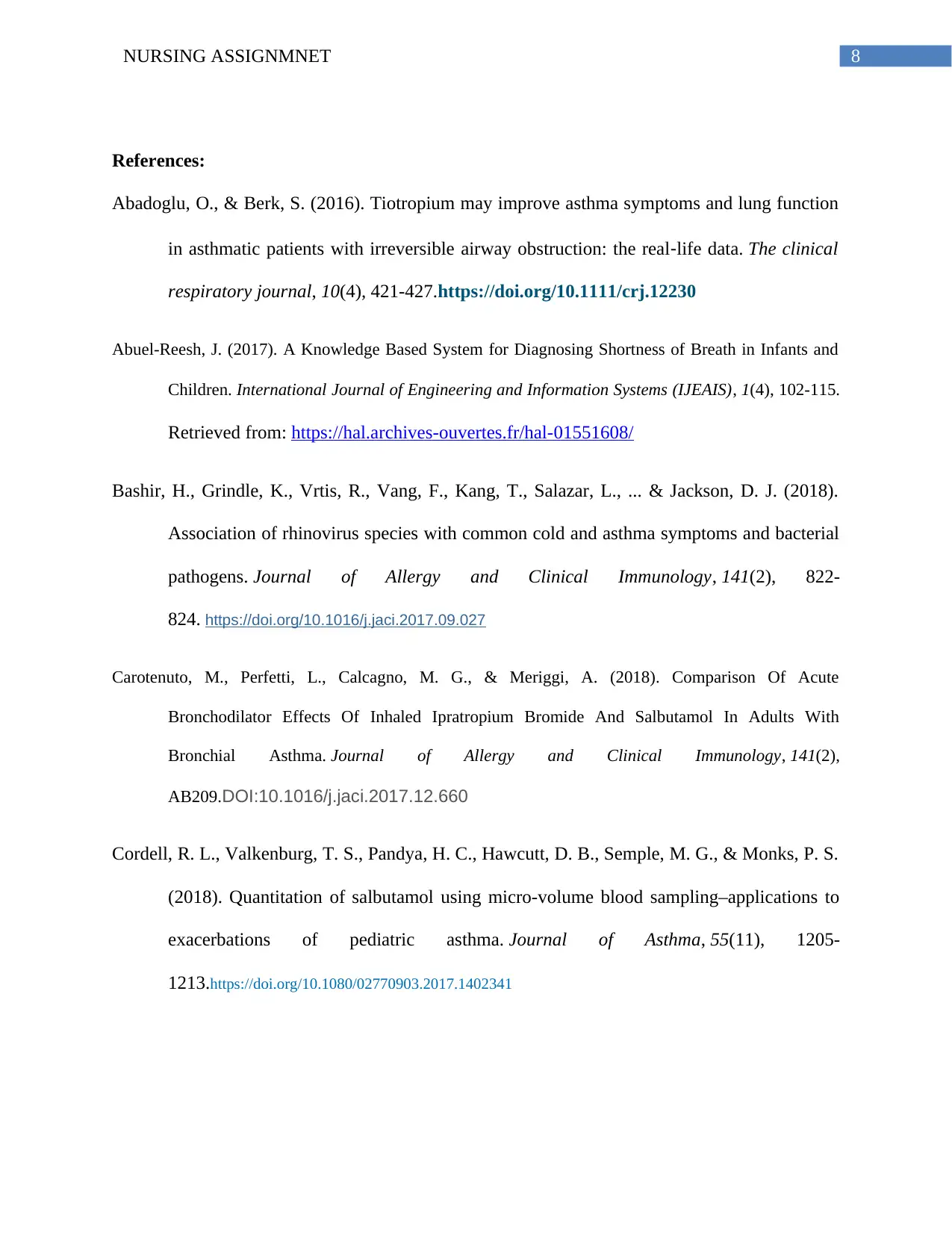
8NURSING ASSIGNMNET
References:
Abadoglu, O., & Berk, S. (2016). Tiotropium may improve asthma symptoms and lung function
in asthmatic patients with irreversible airway obstruction: the real‐life data. The clinical
respiratory journal, 10(4), 421-427.https://doi.org/10.1111/crj.12230
Abuel-Reesh, J. (2017). A Knowledge Based System for Diagnosing Shortness of Breath in Infants and
Children. International Journal of Engineering and Information Systems (IJEAIS), 1(4), 102-115.
Retrieved from: https://hal.archives-ouvertes.fr/hal-01551608/
Bashir, H., Grindle, K., Vrtis, R., Vang, F., Kang, T., Salazar, L., ... & Jackson, D. J. (2018).
Association of rhinovirus species with common cold and asthma symptoms and bacterial
pathogens. Journal of Allergy and Clinical Immunology, 141(2), 822-
824. https://doi.org/10.1016/j.jaci.2017.09.027
Carotenuto, M., Perfetti, L., Calcagno, M. G., & Meriggi, A. (2018). Comparison Of Acute
Bronchodilator Effects Of Inhaled Ipratropium Bromide And Salbutamol In Adults With
Bronchial Asthma. Journal of Allergy and Clinical Immunology, 141(2),
AB209.DOI:10.1016/j.jaci.2017.12.660
Cordell, R. L., Valkenburg, T. S., Pandya, H. C., Hawcutt, D. B., Semple, M. G., & Monks, P. S.
(2018). Quantitation of salbutamol using micro-volume blood sampling–applications to
exacerbations of pediatric asthma. Journal of Asthma, 55(11), 1205-
1213.https://doi.org/10.1080/02770903.2017.1402341
References:
Abadoglu, O., & Berk, S. (2016). Tiotropium may improve asthma symptoms and lung function
in asthmatic patients with irreversible airway obstruction: the real‐life data. The clinical
respiratory journal, 10(4), 421-427.https://doi.org/10.1111/crj.12230
Abuel-Reesh, J. (2017). A Knowledge Based System for Diagnosing Shortness of Breath in Infants and
Children. International Journal of Engineering and Information Systems (IJEAIS), 1(4), 102-115.
Retrieved from: https://hal.archives-ouvertes.fr/hal-01551608/
Bashir, H., Grindle, K., Vrtis, R., Vang, F., Kang, T., Salazar, L., ... & Jackson, D. J. (2018).
Association of rhinovirus species with common cold and asthma symptoms and bacterial
pathogens. Journal of Allergy and Clinical Immunology, 141(2), 822-
824. https://doi.org/10.1016/j.jaci.2017.09.027
Carotenuto, M., Perfetti, L., Calcagno, M. G., & Meriggi, A. (2018). Comparison Of Acute
Bronchodilator Effects Of Inhaled Ipratropium Bromide And Salbutamol In Adults With
Bronchial Asthma. Journal of Allergy and Clinical Immunology, 141(2),
AB209.DOI:10.1016/j.jaci.2017.12.660
Cordell, R. L., Valkenburg, T. S., Pandya, H. C., Hawcutt, D. B., Semple, M. G., & Monks, P. S.
(2018). Quantitation of salbutamol using micro-volume blood sampling–applications to
exacerbations of pediatric asthma. Journal of Asthma, 55(11), 1205-
1213.https://doi.org/10.1080/02770903.2017.1402341
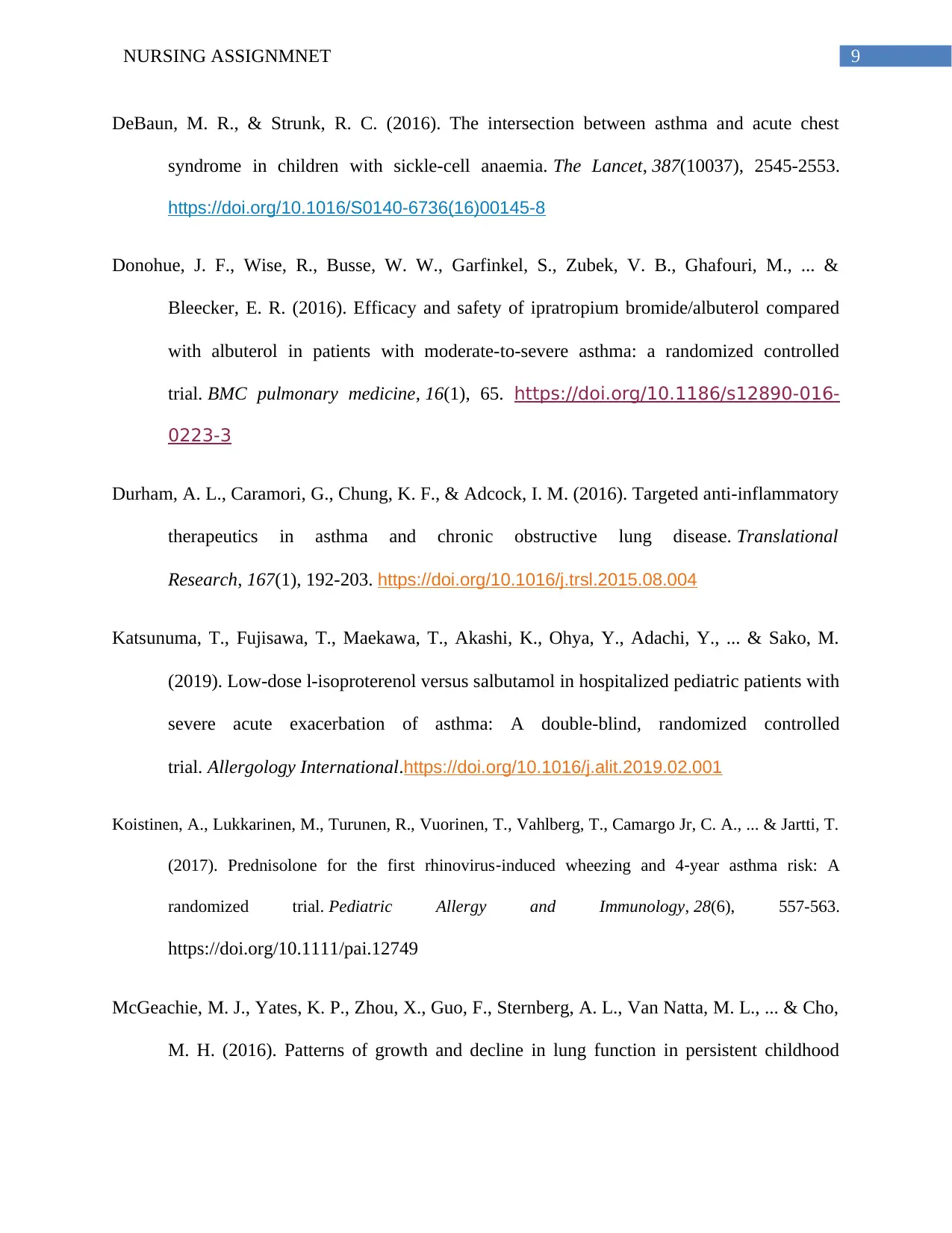
9NURSING ASSIGNMNET
DeBaun, M. R., & Strunk, R. C. (2016). The intersection between asthma and acute chest
syndrome in children with sickle-cell anaemia. The Lancet, 387(10037), 2545-2553.
https://doi.org/10.1016/S0140-6736(16)00145-8
Donohue, J. F., Wise, R., Busse, W. W., Garfinkel, S., Zubek, V. B., Ghafouri, M., ... &
Bleecker, E. R. (2016). Efficacy and safety of ipratropium bromide/albuterol compared
with albuterol in patients with moderate-to-severe asthma: a randomized controlled
trial. BMC pulmonary medicine, 16(1), 65. https://doi.org/10.1186/s12890-016-
0223-3
Durham, A. L., Caramori, G., Chung, K. F., & Adcock, I. M. (2016). Targeted anti-inflammatory
therapeutics in asthma and chronic obstructive lung disease. Translational
Research, 167(1), 192-203. https://doi.org/10.1016/j.trsl.2015.08.004
Katsunuma, T., Fujisawa, T., Maekawa, T., Akashi, K., Ohya, Y., Adachi, Y., ... & Sako, M.
(2019). Low-dose l-isoproterenol versus salbutamol in hospitalized pediatric patients with
severe acute exacerbation of asthma: A double-blind, randomized controlled
trial. Allergology International.https://doi.org/10.1016/j.alit.2019.02.001
Koistinen, A., Lukkarinen, M., Turunen, R., Vuorinen, T., Vahlberg, T., Camargo Jr, C. A., ... & Jartti, T.
(2017). Prednisolone for the first rhinovirus‐induced wheezing and 4‐year asthma risk: A
randomized trial. Pediatric Allergy and Immunology, 28(6), 557-563.
https://doi.org/10.1111/pai.12749
McGeachie, M. J., Yates, K. P., Zhou, X., Guo, F., Sternberg, A. L., Van Natta, M. L., ... & Cho,
M. H. (2016). Patterns of growth and decline in lung function in persistent childhood
DeBaun, M. R., & Strunk, R. C. (2016). The intersection between asthma and acute chest
syndrome in children with sickle-cell anaemia. The Lancet, 387(10037), 2545-2553.
https://doi.org/10.1016/S0140-6736(16)00145-8
Donohue, J. F., Wise, R., Busse, W. W., Garfinkel, S., Zubek, V. B., Ghafouri, M., ... &
Bleecker, E. R. (2016). Efficacy and safety of ipratropium bromide/albuterol compared
with albuterol in patients with moderate-to-severe asthma: a randomized controlled
trial. BMC pulmonary medicine, 16(1), 65. https://doi.org/10.1186/s12890-016-
0223-3
Durham, A. L., Caramori, G., Chung, K. F., & Adcock, I. M. (2016). Targeted anti-inflammatory
therapeutics in asthma and chronic obstructive lung disease. Translational
Research, 167(1), 192-203. https://doi.org/10.1016/j.trsl.2015.08.004
Katsunuma, T., Fujisawa, T., Maekawa, T., Akashi, K., Ohya, Y., Adachi, Y., ... & Sako, M.
(2019). Low-dose l-isoproterenol versus salbutamol in hospitalized pediatric patients with
severe acute exacerbation of asthma: A double-blind, randomized controlled
trial. Allergology International.https://doi.org/10.1016/j.alit.2019.02.001
Koistinen, A., Lukkarinen, M., Turunen, R., Vuorinen, T., Vahlberg, T., Camargo Jr, C. A., ... & Jartti, T.
(2017). Prednisolone for the first rhinovirus‐induced wheezing and 4‐year asthma risk: A
randomized trial. Pediatric Allergy and Immunology, 28(6), 557-563.
https://doi.org/10.1111/pai.12749
McGeachie, M. J., Yates, K. P., Zhou, X., Guo, F., Sternberg, A. L., Van Natta, M. L., ... & Cho,
M. H. (2016). Patterns of growth and decline in lung function in persistent childhood
Paraphrase This Document
Need a fresh take? Get an instant paraphrase of this document with our AI Paraphraser

10NURSING ASSIGNMNET
asthma. New England Journal of Medicine, 374(19), 1842-1852. DOI:
10.1056/NEJMoa1513737
Morikawa, M., Hagiwara, Y., Gibo, K., Goto, T., Watase, H., Hasegawa, K., ... & Imamura, T.
(2019). Methylxanthine use for acute asthma in the emergency department in Japan: a
multicenter observational study. Acute Medicine &
Surgery.https://doi.org/10.1002/ams2.408
Murray, C., Foden, P., Lowe, L., Durrington, H., Custovic, A., & Simpson, A. (2017). Diagnosis
of asthma in symptomatic children based on measures of lung function: an analysis of
data from a population-based birth cohort study. The lancet child & adolescent
health, 1(2), 114-123.https://doi.org/10.1016/S2352-4642(17)30008-1
Rubner, F. J., Jackson, D. J., Evans, M. D., Gangnon, R. E., Tisler, C. J., Pappas, T. E., ... & Lemanske Jr,
R. F. (2017). Early life rhinovirus wheezing, allergic sensitization, and asthma risk at
adolescence. Journal of Allergy and Clinical Immunology, 139(2), 501-507.
https://doi.org/10.1016/j.jaci.2016.03.049
Sousa, A. R., Marshall, R. P., Warnock, L. C., Bolton, S., Hastie, A., Symon, F., ... & Haldar, P.
(2017). Responsiveness to oral prednisolone in severe asthma is related to the degree of
eosinophilic airway inflammation. Clinical & Experimental Allergy, 47(7), 890-
899.https://doi.org/10.1111/cea.12954
Tamada, T., & Ichinose, M. (2016). Leukotriene receptor antagonists and antiallergy drugs.
In Pharmacology and Therapeutics of Asthma and COPD (pp. 153-169). Springer, Cham.
Retrieved from: https://link.springer.com/chapter/10.1007/164_2016_72
asthma. New England Journal of Medicine, 374(19), 1842-1852. DOI:
10.1056/NEJMoa1513737
Morikawa, M., Hagiwara, Y., Gibo, K., Goto, T., Watase, H., Hasegawa, K., ... & Imamura, T.
(2019). Methylxanthine use for acute asthma in the emergency department in Japan: a
multicenter observational study. Acute Medicine &
Surgery.https://doi.org/10.1002/ams2.408
Murray, C., Foden, P., Lowe, L., Durrington, H., Custovic, A., & Simpson, A. (2017). Diagnosis
of asthma in symptomatic children based on measures of lung function: an analysis of
data from a population-based birth cohort study. The lancet child & adolescent
health, 1(2), 114-123.https://doi.org/10.1016/S2352-4642(17)30008-1
Rubner, F. J., Jackson, D. J., Evans, M. D., Gangnon, R. E., Tisler, C. J., Pappas, T. E., ... & Lemanske Jr,
R. F. (2017). Early life rhinovirus wheezing, allergic sensitization, and asthma risk at
adolescence. Journal of Allergy and Clinical Immunology, 139(2), 501-507.
https://doi.org/10.1016/j.jaci.2016.03.049
Sousa, A. R., Marshall, R. P., Warnock, L. C., Bolton, S., Hastie, A., Symon, F., ... & Haldar, P.
(2017). Responsiveness to oral prednisolone in severe asthma is related to the degree of
eosinophilic airway inflammation. Clinical & Experimental Allergy, 47(7), 890-
899.https://doi.org/10.1111/cea.12954
Tamada, T., & Ichinose, M. (2016). Leukotriene receptor antagonists and antiallergy drugs.
In Pharmacology and Therapeutics of Asthma and COPD (pp. 153-169). Springer, Cham.
Retrieved from: https://link.springer.com/chapter/10.1007/164_2016_72
1 out of 11
![[object Object]](/_next/static/media/star-bottom.7253800d.svg)





